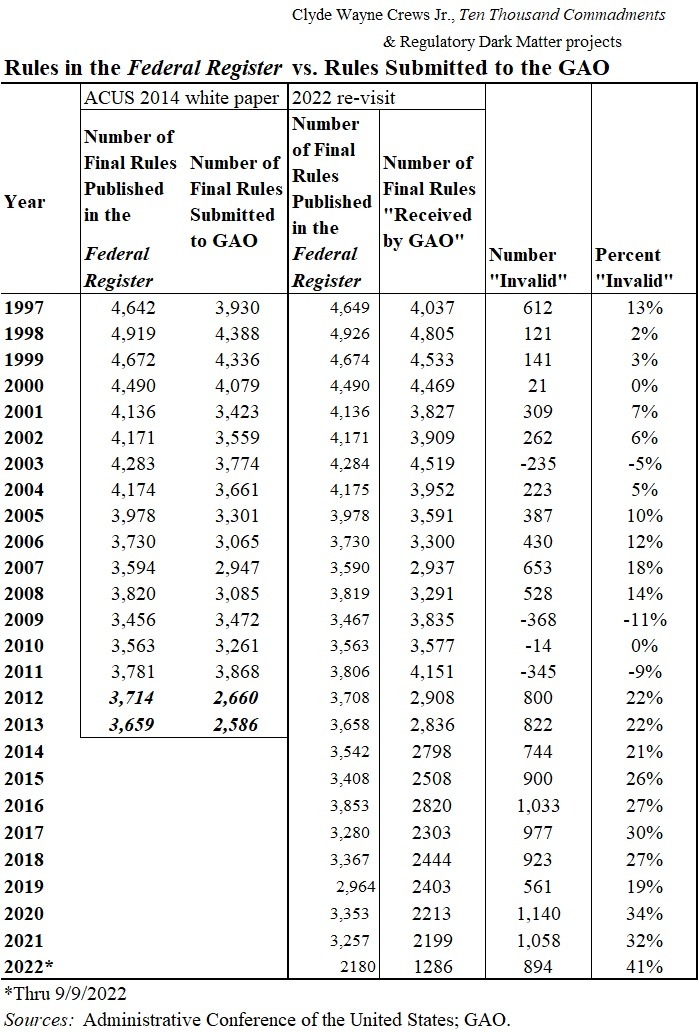Many Federal Agency Rules and Guidance Documents are Still Not Properly Reported to Congress and the GAO

Photo Credit: Getty
A 2014 white paper prepared for the Administrative Conference of the United States (ACUS), “Congressional Review Act: Many Recent Final Rules Were Not Submitted to GAO and Congress,” found that around many rules were not properly submitted to the Government Accountability Office (GAO) as required by the Congressional Review Act (CRA) Here is the form for agencies to do so.
In the preliminary update charted below, I find the problem to have apparently worsened, and in need of legislative scrutiny and correction. According to the GAO’s FAQ, “The CRA requires an agency promulgating a rule to submit the rule to Congress and GAO before it can take effect.”
That reporting represents a formal marker that provides Congress the opportunity to issue a CRA “resolution of disapproval” for expedited reversal of a covered rule.
The GAO maintains a database of CRA reports, by which the ACUS compared the number of rules finalized in the Federal Register with those that had been reported to GAO in 2014. (Most but not all should have been; at the time the proper percentage appeared to hover at about 88 percent).
My preliminary re-visit below finds that, going by gross numbers, many covered rules are likely still not being reported to GAO as required. There is no direct mapping here between covered rules reported to GAO and rules finalized, which is an area for further research, but the percentage level of non-compliance is apparently greater now than it was at the time of the ACUS report, which is also depicted for comparison. That implies a lot of “invalid” rules are out there; this will be a ripe area for Congress to investigate.

And speaking of Congress, the other half of the equation, documentation of the rules reported to Congress and the Senate is not included in the table. At least we can easily locate the GAO database to perform a cursory (or detailed) roundup, but there is no similar tracking capability readily available with respect to reporting to Congress itself. That implies still more invalid rules are out there.
There exist apparent intertemporal oddities with respect to when rules land at GAO and get posted by them. Those aberrations are obvious in the table both in the differences in tallies now compared to the original ACUS pre-2012 retrospective. There also appear “overages” reported by GAO compared to the full-set “anchor” represented by the Federal Register in some calendar years. This latter is an aberration in the sense that the subset cannot be greater than the whole. It is perhaps explained by GAO posting in batches or by some rules being re-applied to an adjacent calendar year. Regardless, mapping could be done for those so inclined.
To be sure, many of these rules implicated in non-compliance are regarded as inconsequential (“routine or informational” is how ACUS categorized them in 2014). Given the prominence of administrative and informational rules in fields such as health care, retirement, insurance, and aviation, treating these as routine implies a resignation to what CEI founder Fred L. Smith Jr. called the derailment of private institutions and their replacement with centralized administration.
A quick remedy for the issues of failure to report rules would be legislation to require documentation of the reporting of covered rules to both GAO and to Congress (for example in the Federal Register and in the Congressional Record). Reporting to GAO may be riddled with errors, but it at least can be found and assessed. CRA reporting is unfortunately only one of several instances of deterioration in disclosure and accountability in recent years. Beyond all this, Congress needs to affirm that unreported rules will be deemed invalid.
These are important fixes, because the real problem of non-compliance with the CRA goes deeper than just the “rules” above. According to the Congressional Review Act, federal agency guidance documents are covered “rules” as well, yet their reporting to Congress and the GAO is even more abysmal. Guidance documents are not even captured in the GAO reporting form OMB noted above.
Before the mandatory Trump-era guidance portals now stricken by Biden, Congress had to pull teeth to find out about guidance document reporting, and was forced to conclude that it doesn’t happen (see the 2018 House Committee on Oversight and Government Reform Report “Shining Light on Regulatory Dark Matter”). These, too, should be regarded as invalid.
The formal presentment of rules and guidance to the GAO and Congress to provide the opportunity for the latter to initiate a resolution of disapproval is important. Congress can ensure that CRA-compliant reporting happens, and stop pretending non-compliance is OK.